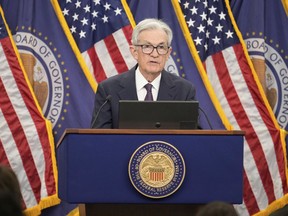
Article content
NEW YORK (AP) — All the major banks passed the Federal Reserve’s annual “stress tests” of the financial system, the central bank said Friday, but the test conducted by the central bank was notably less vigorous than it had been in previous years.
THIS CONTENT IS RESERVED FOR SUBSCRIBERS ONLY
Subscribe now to read the latest news in your city and across Canada.
- Exclusive articles from Barbara Shecter, Joe O'Connor, Gabriel Friedman, and others.
- Daily content from Financial Times, the world's leading global business publication.
- Unlimited online access to read articles from Financial Post, National Post and 15 news sites across Canada with one account.
- National Post ePaper, an electronic replica of the print edition to view on any device, share and comment on.
- Daily puzzles, including the New York Times Crossword.
SUBSCRIBE TO UNLOCK MORE ARTICLES
Subscribe now to read the latest news in your city and across Canada.
- Exclusive articles from Barbara Shecter, Joe O'Connor, Gabriel Friedman and others.
- Daily content from Financial Times, the world's leading global business publication.
- Unlimited online access to read articles from Financial Post, National Post and 15 news sites across Canada with one account.
- National Post ePaper, an electronic replica of the print edition to view on any device, share and comment on.
- Daily puzzles, including the New York Times Crossword.
REGISTER / SIGN IN TO UNLOCK MORE ARTICLES
Create an account or sign in to continue with your reading experience.
- Access articles from across Canada with one account.
- Share your thoughts and join the conversation in the comments.
- Enjoy additional articles per month.
- Get email updates from your favourite authors.
THIS ARTICLE IS FREE TO READ REGISTER TO UNLOCK.
Create an account or sign in to continue with your reading experience.
- Access articles from across Canada with one account
- Share your thoughts and join the conversation in the comments
- Enjoy additional articles per month
- Get email updates from your favourite authors
Sign In or Create an Account
or
Article content
All 22 banks tested this year would have remained solvent and above the minimum thresholds to continue to operate, the Fed said, despite absorbing roughly $550 billion in theoretical losses. In the Fed’s scenario, there would be less of a rise in unemployment, less of a severe economic contraction, less of a drop in commercial real estate prices, less of a drop in housing prices, among other metrics compared to what they tested in 2024.
Article content
Article content
Article content
All of these less harmful, but simulated, drops mean there would be less damage to these banks’ balance sheets and less risk of these banks of potentially failing. Since the banks passed the 2024 tests, it was expected that the banks would pass the 2025 tests.
Article content
By signing up you consent to receive the above newsletter from Postmedia Network Inc.
Article content
“Large banks remain well capitalized and resilient to a range of severe outcomes,” said Michelle Bowman, the bank’s vice chair for supervision, in a statement. An appointee of President Trump, Bowman became the Fed’s vice chair of supervision earlier this month.
Article content
It’s not clear why the Fed chose to go with a less vigorous test this year. In a statement, the bank said previous tests had shown “unintended volatility” in the results and it plans to seek public and industry comment to adjust stress tests in future years. The Fed also chose to not test the banks as heavily on their exposure to private equity assets, arguing that private equity assets are typically held for the long term and are not typically sold at times of distress.
Article content
The Fed also didn’t test for any bank exposure to private credit, a $2 trillion asset class that even Fed researchers themselves have observed to be growing alarmingly quickly. The Federal Reserve Bank of Boston recently pointed out that private credit could be a systemic risk to the financial system under a severe adverse scenario, which is exactly what the stress tests are supposed to test for.
Article content
Article content
There was no wording or phrasing in the Fed’s press release, reports or methodology about testing or measuring private credit or private debt in this year’s test.
Article content
The Fed’s “stress tests” were created after the 2008 financial crisis as a way to gauge whether the nation’s “too big to fail” banks could withstand another financial crisis like the once that happened nearly 20 years ago. The tests are effectively an academic exercise, where the Fed simulates a scenario in the global economy and measures what that scenario would do to bank balance sheets.
Article content
The 22 banks that are tested are the biggest names in the business, such as JPMorgan Chase, Citigroup, Bank of America, Morgan Stanley and Goldman Sachs, which hold hundreds of billions of dollars in assets and have wide-ranging businesses that touch every part of the U.S. and global economy.
Article content
Under this year’s hypothetical scenario, a major global recession would have caused a 30% decline in commercial real estate prices and a 33% decline in housing prices. The unemployment rate would rise to 10% and stock prices would fall 50%. In 2024, the hypothetical scenario was a 40% decline in commercial real estate prices, a 55% decline in stock prices and a 36% decline in housing prices.
Article content
With their passing grades, the major banks will be allowed to issue dividends to shareholders and buy back shares of stock to return proceeds to investors. Those dividend plans will be announced next week.
Article content

.jpg) 4 hours ago
3
4 hours ago
3
 English (US)
English (US)